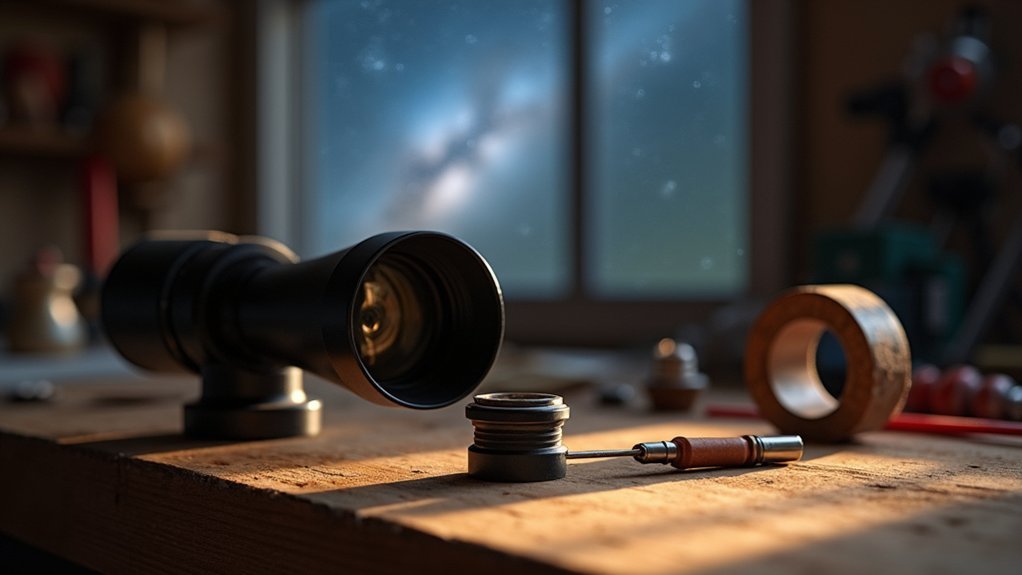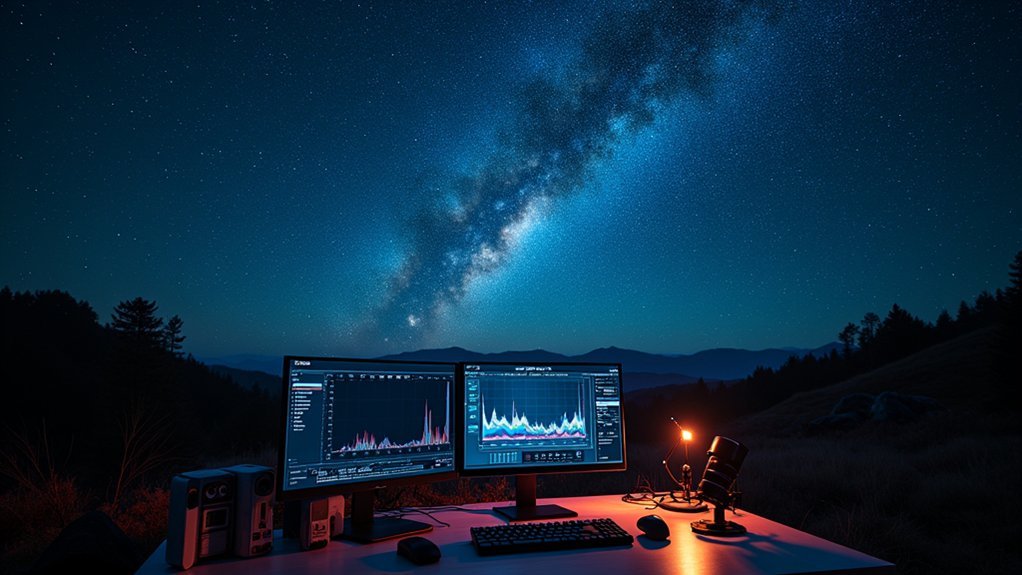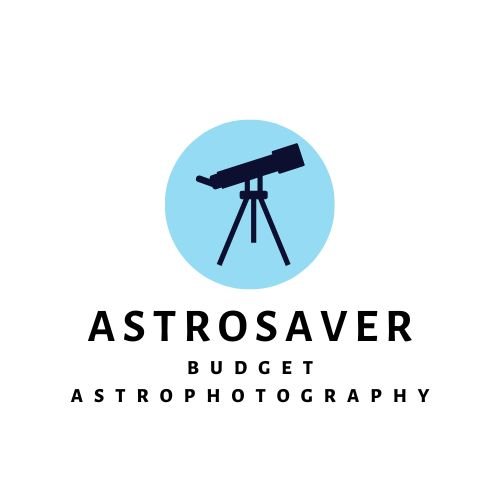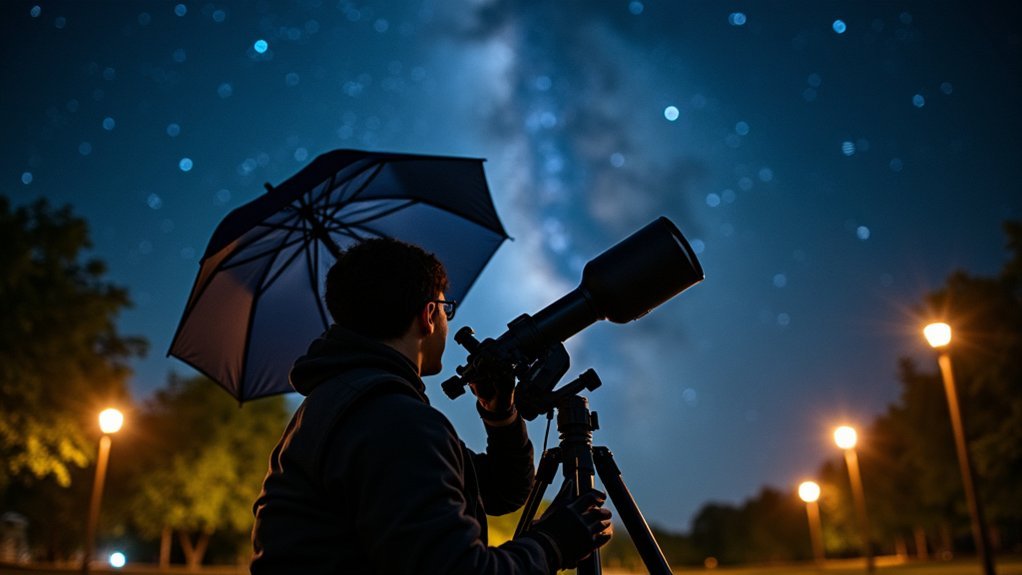Instead of an expensive field flattener, you can use budget focal reducers like the SVBONY or Hotech SCA models, which both reduce focal length and correct curvature. Camera lens adapters offer another affordable option. For DIY solutions, repurpose lenses from old cameras or binoculars with proper spacing adjustments. Small-sensor cameras naturally minimize edge distortion. Post-processing techniques like cropping and gradient removal can also improve star shapes. These alternatives deliver impressive results without breaking the bank.
What Can Replace an Expensive Telescope Field Flattener?

When faced with the steep price of dedicated field flatteners, you’ll be pleased to know several alternatives exist.
High-quality focal reducers can pull double duty by both shortening focal length and correcting field curvature, offering a cost-effective substitute for a premium field flattener.
If you’re on a tight budget, generic field flatteners may deliver adequate results, particularly when paired with smaller sensor cameras.
Don’t overlook DIY solutions either – repurposed optical elements from old camera lenses or telescopes can work surprisingly well if properly calibrated for your setup.
You can also experiment with spacing adjustments between your existing equipment components.
Sometimes, simply using a camera with a smaller sensor will minimize visible edge distortion enough to eliminate the immediate need for a dedicated field flattener.
Understanding Field Curvature in Refractor Telescopes
In refractor telescopes, you’ll encounter field curvature where light focuses on a curved plane rather than a flat one, causing peripheral stars to appear distorted while central stars remain sharp.
This optical aberration becomes more pronounced in telescopes with faster focal ratios (lower f-numbers) and larger apertures, affecting astrophotography results particularly with larger camera sensors.
The physics behind this phenomenon relates to how light rays travel through lenses at different angles, creating a natural curvature of field that requires correction for edge-to-edge sharpness in your images.
Curved Focal Plane Basics
Three fundamental principles govern how light focuses through a refractor telescope, with field curvature being among the most important for astrophotographers.
When light passes through your refractor’s lens system, it doesn’t focus on a flat plane but rather curves outward, creating what’s known as field curvature. This means stars at the center of your image appear sharp while those at the edges look blurry and distorted.
- Field curvature is more pronounced in telescopes with longer focal ratios
- Doublet refractors typically exhibit more severe curvature than triplet designs
- The curved focal plane creates an uneven focus across your imaging field
- This optical phenomenon becomes particularly problematic in wide-field astrophotography
Understanding this curvature is essential before attempting to correct it, as different telescope designs produce varying degrees of distortion.
Star Distortion Effects
Field curvature manifests most visibly through star distortion—the telltale signature that frustrates many astrophotographers. When you observe or photograph through a refractor without field flatteners, stars gradually transform from pinpoints at the center to elongated blobs near the edges.
This distortion becomes more pronounced in longer focal length instruments, where stars appear increasingly misshapen as you move away from the optical axis. What you’re seeing is “coma,” where perfectly round stars stretch into comet-like shapes at the field’s periphery.
Your telescope design greatly impacts distortion severity. Triplet refractors typically deliver better edge performance than doublet designs.
Additionally, your camera sensor size matters—larger full-frame sensors reveal edge imperfections more dramatically than smaller APS-C sensors, which capture less of the curved focal plane.
Optical Physics Explained
When you examine the optical physics behind refractor telescopes, you’ll discover that field curvature represents a fundamental challenge rather than a manufacturing defect. Your telescope’s lens naturally projects images onto a curved focal plane, while your camera sensor is flat—creating an unavoidable mismatch.
This curvature becomes more pronounced with:
- Longer focal lengths, where the curve’s radius increases
- Faster apertures (lower f-ratios), amplifying edge distortion
- Wider field imaging, revealing more of the curved focal plane
- Larger camera sensors that extend into the curved field
You’re fundamentally trying to project a curved image onto a flat surface.
Without correction, stars appear sharp in the center but progressively blurrier toward the edges—a particular problem for astrophotography where pinpoint stars throughout the field are vital.
Budget-Friendly Focal Reducers as Flattener Alternatives
Several cost-effective focal reducers offer a practical alternative to dedicated field flatteners, providing dual functionality that budget-conscious astrophotographers will appreciate.
The SVBONY Focal Reducer and Hotech SCA models not only decrease your telescope’s focal length but also correct field curvature simultaneously.
These budget-friendly focal reducers typically work best with specific focal ratios (f/5 to f/8) and feature standard M48x0.75 threads for easy camera connection.
You’ll find they’re surprisingly versatile across different imaging setups.
While they require careful setup for ideal results, many users report minimal edge distortion and impressive image quality.
Their lightweight design is an added bonus, reducing strain on your mount’s payload capacity.
For astrophotographers watching their expenses, these dual-purpose tools deliver considerable value without sacrificing performance.
Camera Lens Adapters That Reduce Field Distortion

You don’t need to spend hundreds on dedicated field flatteners when camera lens adapters can effectively reduce field distortion in your astrophotography setup.
Many budget-friendly focal reducers like the SVBONY model offer dual benefits of shortening focal length while simultaneously flattening the field.
If you’re feeling adventurous, you can even create DIY adapter solutions by experimenting with different spacer configurations to achieve the ideal working distance for your specific telescope.
Budget Flattening Solutions
Astronomers on a budget don’t need to sacrifice edge-to-edge sharpness in their astrophotography. Several affordable alternatives can replace expensive field flatteners while maintaining good image quality.
The SVBONY Focal Reducer stands out as a dual-purpose solution, functioning as both a field flattener and focal reducer to deliver wider views and sharper star points at the edges of your frames.
- Generic third-party flatteners can be customized with thin spacers to achieve ideal backfocus.
- Hotech Flatteners offer good performance when properly adjusted for working distance.
- Camera lens adapters effectively minimize field distortion at a fraction of premium prices.
- Community forums can guide you to budget-friendly options tested by fellow astrophotographers.
With these cost-effective solutions, you’ll capture impressive deep-sky images without the premium price tag.
DIY Adapter Options
While expensive commercial solutions dominate the market, crafting your own field flattening system provides a rewarding alternative that can deliver surprising results at a fraction of the cost. You can build adapters using standard T-rings and 2-inch components to create custom optical paths that reduce field distortion.
| Adapter Type | Materials Needed | Benefits |
|---|---|---|
| Extension Tube | T-ring, spacers | Achieves proper back focus |
| Lens Converter | Camera lens, focal reducer | Utilizes built-in corrections |
| Budget Adapter | Photography store adapters | Simple alignment solution |
Experiment with different focal lengths by combining extension tubes with appropriate spacers. This DIY approach lets you fine-tune the spacing for ideal star points across your image field. Many photographers have successfully used cheap lens adapters as field flattener alternatives by ensuring proper alignment between components.
DIY Flattener Solutions Using Surplus Optical Components
Because commercial field flatteners can be prohibitively expensive, creative astrophotographers have discovered ways to build their own using readily available surplus optical components. You can achieve a flat field effect by repurposing lenses from old cameras or binoculars, combined with proper mounting and spacing techniques.
- Experiment with doublet or triplet lens combinations to eliminate edge distortion in your images.
- Position your DIY flattener at the correct working distance (typically around 55mm) from your camera sensor.
- Source surplus optical elements from community forums where successful designs are freely shared.
- Test different focal length lenses to find the ideal match for your specific telescope setup.
The key to success lies in precise spacing and lens selection. With some patience and experimentation, you’ll enjoy dramatically improved edge-to-edge sharpness in your astrophotography.
Post-Processing Techniques to Correct Edge Distortion

Even without a physical field flattener, you can still achieve impressive results by mastering digital correction techniques. Your post-processing toolkit can compensate for issues that would typically require a specific visual back or back focus adjustment.
| Technique | Application | Result |
|---|---|---|
| Cropping | Edge removal | Focused composition |
| Lens Correction | Profile-based fixes | Reduced distortion |
| Image Stacking | Multiple frame averaging | Improved edge detail |
| Gradient Removal | Edge brightness correction | Uniform field |
Software like Adobe Lightroom and PixInsight offer specialized tools that effectively address edge distortion. By applying these corrections, you’ll maintain a wider field of view than severe cropping while preserving stellar shapes. Remember that proper initial calibration of your imaging setup greatly reduces the amount of post-processing required, saving you time and preserving image data.
Frequently Asked Questions
Is a Field Flattener Necessary?
Yes, you’ll need a field flattener for astrophotography to correct curvature distortion. Without one, your images will show blurry, distorted stars at the edges, especially with larger sensors during long exposures.
Is a Coma Corrector the Same as a Field Flattener?
No, a coma corrector isn’t the same as a field flattener. You’ll use a coma corrector to fix coma distortion in fast telescopes, while field flatteners address field curvature for sharper edge-to-edge focus.
Do I Need a Focal Reducer for My Telescope?
You’ll need a focal reducer if you want wider field of view, brighter images for astrophotography, or correction of field curvature. It depends on your telescope type and imaging goals.
What Does a Reducer Flattener Do?
A reducer flattener shortens your telescope’s focal length, giving you wider views and brighter images. It also corrects field curvature, ensuring stars remain sharp across your entire frame—essential for quality astrophotography with edge-to-edge sharpness.
In Summary
You’ve got several options to avoid purchasing an expensive field flattener. Try affordable focal reducers, repurpose camera lens adapters, or experiment with DIY solutions using surplus optical components. Don’t forget that post-processing software can effectively correct edge distortion in your images. While not perfect replacements, these alternatives can greatly improve your astrophotography results without breaking the bank. Weigh each option against your specific needs and budget.





Leave a Reply